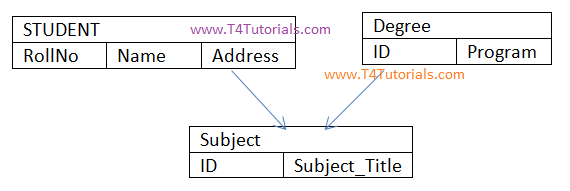Network model in the database with examples and characteristics.
What is the network model in dbms?
When we want to design the database, there is a variety of database models. Relational, hierarchical, and network models are famous models. In this tutorial, we will explore the database network model.
The network database model is a model for modeling the entities in such a way that one child entity can have more than one parent entity. In 1969, the network model was presented by Charles Bachman.
Example of a network model

In this figure, we can see that the subject is the child class and student and degree are the parent classes.
So, the subject has two parent classes. STUDENT has one child and the Degree class also have one child.
This kind of relationship among entities represents the network model.
Examples of network databases
Examples of some famous network databases are,
- TurboIMAGE
- Integrated Data Store (IDS)
- Raima Database Manager
- Univac DMS-1100
- IDMS (Integrated Database Management System)
Characteristics of the network model
There are many characteristics of the network model, some of these characteristics are mentioned below;
- Not always, but in majority of situations network model is best than a hierarchical model.
- Supports many to many relationships.
- Many parents can have many children andChildren can have many parents.
- Entities are represented as a connected network with each other.
- One child entity can have more than one parent entity. For example, in the figure, the Subject has two children. One child is a STUDENT and another one is Degree.
- Represented as a network and one child can have more than one parent. This model represents a complex structure.
- Entities can have multiple parent entities and lead to a complex structure.
- Not very flexible to reorganize the model.
- The performance of the network data model can vary depending on the specific use case and the complexity of the relationships being modeled but mostly having high performance provide high performance for data retrieval
- Relationships among databases are done by programmers by using 3GL programs. Some examples of popular 3GLs include: C, Java, FORTRAN, COBOL, Python.
Network model VS Hierarchical model VS Relational model:
| Network Data Model | Hierarchical Data Model | Relational Data Model |
| Pointers or links are used to express the relationship between records. | The relationship between records is of the parent-child type. | A relation(that contains a key for each record involved in the relationship) is used to represent the relationship between records. |
| It is possible to implement the Many to many relationships. | Many to many relationships cannot be expressed in Hierarchical Data Model. | It is easy to implement Many to many relationships. |
| No problem of inconsistency exists in the Network model. | The data inconsistency is possible when we update or delete some records. | 7. Its needs to maintain Data integrity and consistency by maintaining the database Normalization. For example 1st NF, 2nd NF, 3rd NF, 3.5 NF, 4 NF, and so on. |
| Record relationship implementation is quite complex due to the use of pointers. | The method of implementing the record relationships is;
· Simple · Natural · straightforward |
The use of a key or composite key field plays a role in making the process easy for the implementation of relationships. |
| In-Network model record relations are physical. | The record relations are physical in the Hierarchical data model. | Data is organized logically in the form of rows and columns and stored in the table.
The relational model does not maintain a physical connection among records. |
| Searching for a record is easy since there are multiple access paths to a data element. | Searching for a record is very difficult because we can retrieve a child only after going through its parent record. | A unique, indexed key field is used to search for a data element in a relation. |
| The network model is useful for representing such records that have many to many relationships. | The hierarchical Data Model is useful only when there is some hierarchical character in the database. | The relational model is useful for representing most of the real-world objects and relationships among the objects. |
Advantages of the network model
- It is fast data access with a network model.
- The network model allows creating more complex and more strong queries as compared to the database with a hierarchical database model. A user can execute a variety of database queries when selecting the network model.
- Sometimes, the network model is used to build computer network systems.
- The network model is considered as an enhancement to the hierarchical database model.
Disadvantages of a network model
- The network model is a very complex database model, so the user must be very familiar with the overall structure of the database.
- Updating the database is a quite difficult and boring task. We need the help of the application programs that are being used to navigate the data.
| Test Your Understandings |
1. Network model supports many to many relationships ? YES / NO[su_spoiler title=”Answer – Click Here:” class=”padding: -10px;”]Yes[/su_spoiler]
2. Network model is more complex than hierarchical model? YES / NO[su_spoiler title=”Answer – Click Here:” class=”padding: -10px;”]No[/su_spoiler]
3. Network model relationships are written in ………language?
(a) 1GL
(b) 2GL
(c) 3GL
(d) None of them
[su_spoiler title=”Answer – Click Here:” class=”padding: -10px;”]C[/su_spoiler]
Network model Research Topics Ideas in DBMS
